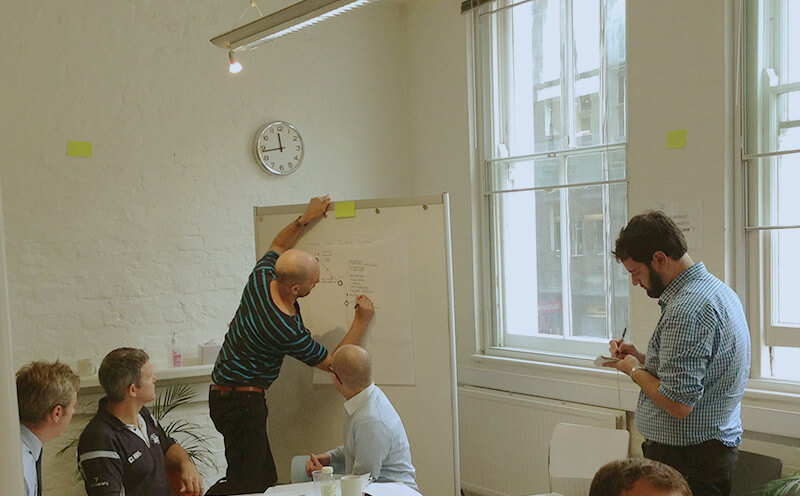Design thinking: Making it pay off | Intro
In this series, we look at the four biggest obstacles to making design thinking pay off, and show you how to overcome them.
Why it matters
Organizations of all shapes and sizes are waking up. Innovation and agility aren’t optional.
Gone are the days of a select few working on innovation while everyone else grinds along in the status quo. Now, the most successful companies strive to foster a culture of innovation – enabling more people to identify and respond to new opportunities and threats as they emerge – all as part of day-to-day work.
To this end, a lot of investment is going into building innovation capability. For those who get it right, this investment pays off. In addition to hitting KPI’s, improving employee engagement, and boosting customer satisfaction, design capability translates into concrete revenue growth. [1]

For most of these organizations, capability building starts with training. Companies like IBM, P&G, and others have implemented large scale programs that reach thousands of employees each year, and in some cases made design thinking training mandatory for all new hires.
In our work with global top 100 companies, we’ve seen the incredible impact that the right program can have, not just in building innovation skills, but in shifting an organization’s culture towards greater customer focus and agility. However, we have also seen organizations fall short, failing to translate even the best learning experience into real business results.
What’s getting in the way
We’ve all been there.
You’ve just left an inspirational workshop: energized and fizzing with ideas, you can’t wait to put these new tools to work! But back at the office, reality kicks in. You find that the realities of day-to-day working life are getting in the way, making it hard to get started, much less make a real impact. Feeling discouraged, you begin to wonder if all this user empathy and rapid prototyping stuff is for other, more innovative companies. Maybe design thinking just doesn’t work here.
Sound familiar?
You’re not alone.

At Treehouse, we’ve spent the last decade helping organizations build internal innovation capability. Along the way, we’ve had great successes, but have also heard the frustrations of workshop attendees who struggle to get traction with design thinking back in their world.
In response, our team of designers and facilitators went into the field. We spent 12 months speaking with and observing leaders, managers, and front-line staff. We hunted for answers across industries and geographies, determined to identify what really stops people from putting design thinking to work. Four clear themes emerged:
- TIME: People’s time is already committed, or over-committed, to delivering business-as-usual results on tight deadlines. Applying design thinking can feel like an added stress on this already scarce resource.
- STRUCTURE: Many organizations are not yet set up to accommodate new ways of working. When the right tools, support systems, and reward mechanisms aren’t in place, people can feel like they’re trying to play a new game by an old set of rules.
- DISTANCE: When people from across functions and geographies come together for a workshop, a certain buzz that comes from this diversity is created. When everyone disperses, that magic along with the collective drive to do things differently is hard to sustain.
- CONFIDENCE: Without first hand experience of getting a great outcome in their world, people hesitate to try new approaches when results really matter, and even small failures may not be tolerated.
Looking at these four barriers, we can see each is linked to the organization’s culture. The rate at which change happens depends on the prevailing attitudes toward risk, hierarchy, short versus long term ROI, and change itself.
In short, these barriers are not likely to disappear anytime soon, so the real challenge is to find creative ways of working around them that are within our realm of control.
In this series, we look at each of these barriers in turn, offering practical strategies to overcome them. We’ll explore the mindsets, tools, and behaviours that anyone, regardless of role, can use to create the conditions for innovation – and make design thinking pay off.
[1] “The Design Management Institute’s 2015 Design Value Index (DVI), based on a portfolio of 16 publicly traded stocks from companies considered to be “design-centric” contingent on a set of criteria that reflects best practices in design management, shows a 211% return over the S&P 500. This marks the third year in a row we have seen such results in excess of 200% over the S&P.” Source: https://www.dmi.org/page/2015DVIandOTW?
